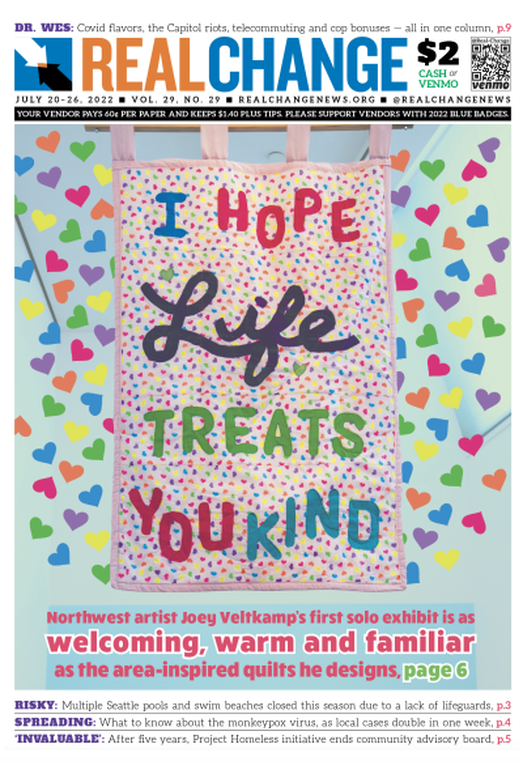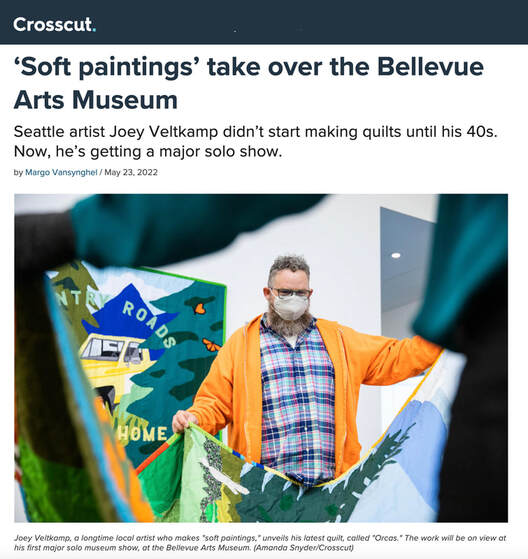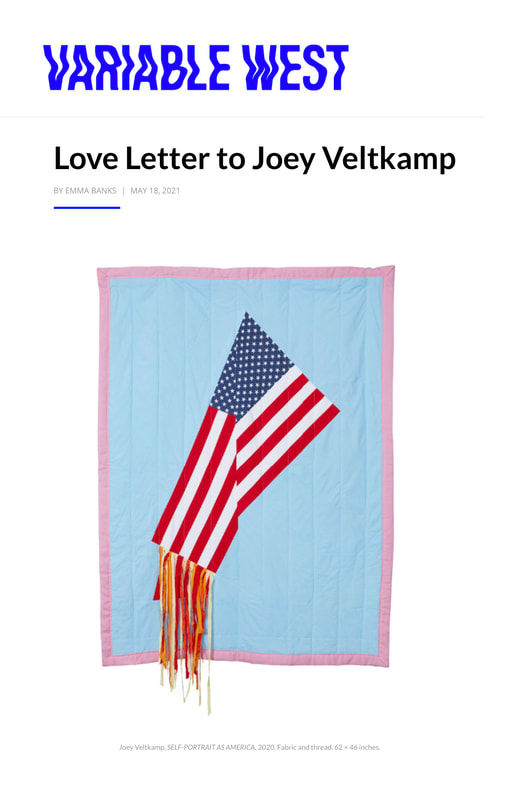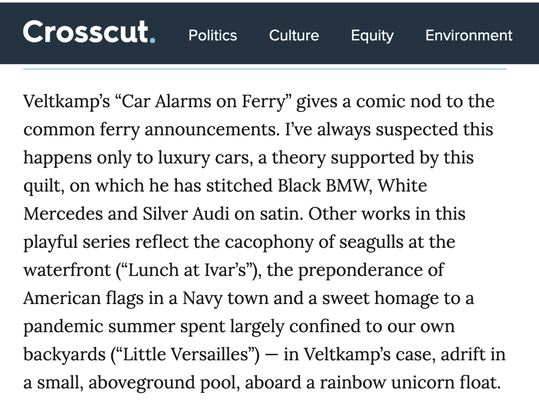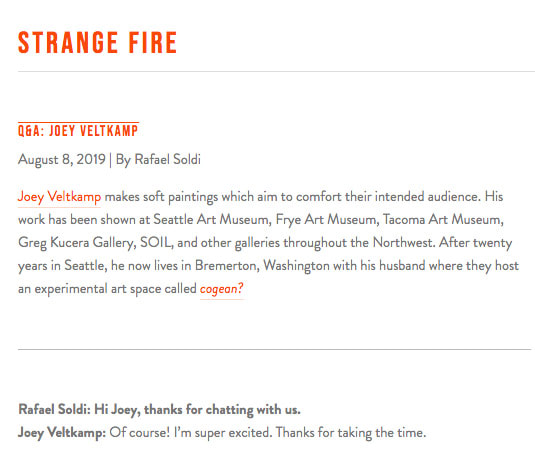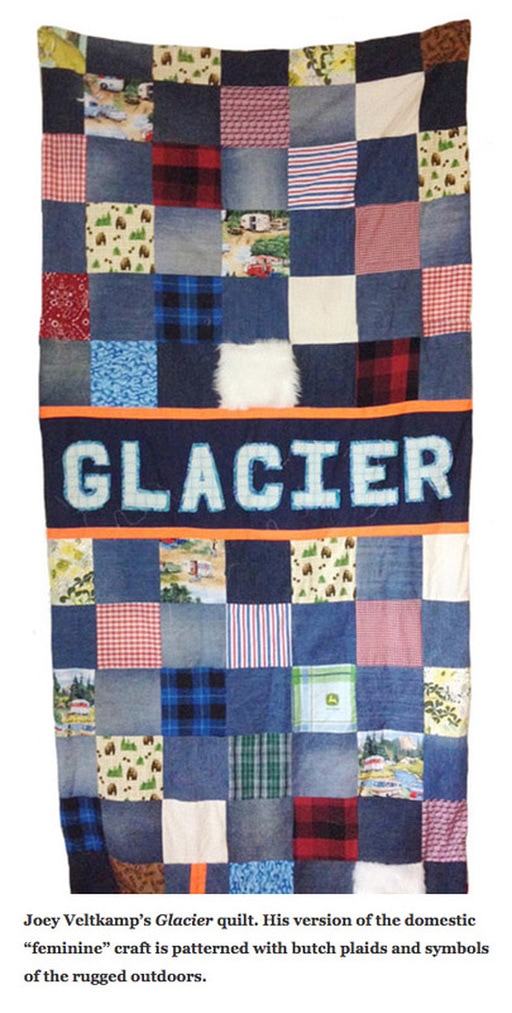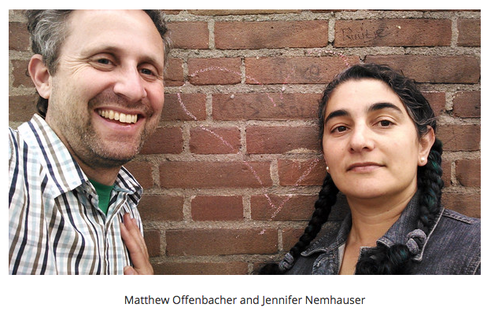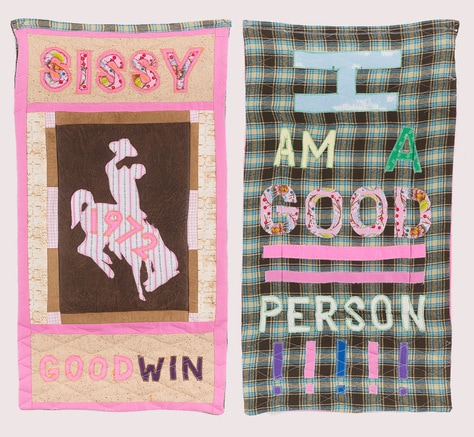2023
2022
2021
And at Greg Kucera Gallery, Bremerton-based multidisciplinary artist Joey Veltkamp shows a series of quilts or “soft paintings,” as he prefers to call them, in the new show Lumberton, Wash. Having lived in Seattle for 20 years before moving to Bremerton in 2016, he says his view of the city has quite literally changed — now he appreciates it as the ferry approaches the downtown waterfront.
Veltkamp’s “Car Alarms on Ferry” gives a comic nod to the common ferry announcements. I’ve always suspected this happens only to luxury cars, a theory supported by this quilt, on which he has stitched Black BMW, White Mercedes and Silver Audi on satin. Other works in this playful series reflect the cacophony of seagulls at the waterfront (“Lunch at Ivar’s”), the preponderance of American flags in a Navy town and a sweet homage to a pandemic summer spent largely confined to our own backyards (“Little Versailles”) — in Veltkamp’s case, adrift in a small, aboveground pool, aboard a rainbow unicorn float.
Veltkamp’s “Car Alarms on Ferry” gives a comic nod to the common ferry announcements. I’ve always suspected this happens only to luxury cars, a theory supported by this quilt, on which he has stitched Black BMW, White Mercedes and Silver Audi on satin. Other works in this playful series reflect the cacophony of seagulls at the waterfront (“Lunch at Ivar’s”), the preponderance of American flags in a Navy town and a sweet homage to a pandemic summer spent largely confined to our own backyards (“Little Versailles”) — in Veltkamp’s case, adrift in a small, aboveground pool, aboard a rainbow unicorn float.
2019
RS: Your fabric works (aka soft paintings), which started as quilted flags and later large-scale quilts often employ text and, to the layperson, seem to wax humor and optimism only. However, these affirmations often mask a certain darkness. What interests you about meeting life’s bleak underbelly with lighthearted positivity? Is one more important than the other, or do they work in tandem?
JV: Yes, the soft paintings are a bit deceptive because they lure you in with bright colors and the text, but then if you spend a little more time with them, you realize they’re more ambiguous than you might have initially thought. I think that life can be awful, but I also think that life can be beautiful. And when I focus on the beauty, I feel guilty for not doing enough to call out the bad stuff in the world. And when I just focus on the bad stuff, I feel bad for not being more thankful for all the good things. So again, it goes back to the idea of balance. I try to make work that walks the line between hopeful and hopeless, because I spend a lot of time there.
JV: Yes, the soft paintings are a bit deceptive because they lure you in with bright colors and the text, but then if you spend a little more time with them, you realize they’re more ambiguous than you might have initially thought. I think that life can be awful, but I also think that life can be beautiful. And when I focus on the beauty, I feel guilty for not doing enough to call out the bad stuff in the world. And when I just focus on the bad stuff, I feel bad for not being more thankful for all the good things. So again, it goes back to the idea of balance. I try to make work that walks the line between hopeful and hopeless, because I spend a lot of time there.
2018
Veltkamp emphasized that these are long-lasting effects of institutional neglect and erasure, which the generation of LGBT activists before him had faced, lived through, and confronted. However, he acknowledged, things are different now. The vibrant colors of Veltkamp’s work capture the dissonance of a progressing society, but one that is doing so on the backs and suffering of the marginalized.
My throat began to feel as dry as the quilt. It was—and is—a lot to process.
“It [What A Time To Be Alive] is deceptively bright and happy,” Veltkamp explained, “and if you’re just walking by you can read it like, ‘Oh wow, what a time to be alive,’ but if you spend more time with it you’ll eventually be like, ‘Ugh, weird, what a time to be alive’ and that’s where I think that piece lives.”
My throat began to feel as dry as the quilt. It was—and is—a lot to process.
“It [What A Time To Be Alive] is deceptively bright and happy,” Veltkamp explained, “and if you’re just walking by you can read it like, ‘Oh wow, what a time to be alive,’ but if you spend more time with it you’ll eventually be like, ‘Ugh, weird, what a time to be alive’ and that’s where I think that piece lives.”
"He unfolds a huge grass-green quilt by Joey Veltkamp, designed to look just like the highway exit sign for Bellevue. “I asked people to respond to Bellevue,” he explains."
"There are fathers in the show, too.
“I never thought I’d get the chance to have kids because I was queer!” laughs Joey Veltkamp, an artist who often works with textiles, quilts, and blankets.
“And then my best friends"—a lesbian couple—"wanted kids and suddenly it became a possibility! So the kids get amazing moms with some artsy-fartsy dads on the side! And both kids identify as artists!”
In the show, Veltkamp is exhibiting baby dresses that he made for his daughter."
“I never thought I’d get the chance to have kids because I was queer!” laughs Joey Veltkamp, an artist who often works with textiles, quilts, and blankets.
“And then my best friends"—a lesbian couple—"wanted kids and suddenly it became a possibility! So the kids get amazing moms with some artsy-fartsy dads on the side! And both kids identify as artists!”
In the show, Veltkamp is exhibiting baby dresses that he made for his daughter."
Joey Veltkamp is a Seattle-based artist who makes quilts to convey both comfort and uncomfortable truths. These flags are made from titles of songs he listens to for survival, and colors of LGBTQ various flags🏳️🌈. @joeyveltkamp#quilts #textileart #fbairprogram#lgbtpride #seattleartist #fbseattle
“I’ve seen orcas. Twice!” Joey Veltkamp enthuses about the ferry ride between Bremerton and Seattle. As he talks, his arm nearly brushes a large pink quilt that reads “WE’RE ALL GONNA DIE”—the centerpiece of his solo show, Blue Skies Forever, opening tonight here in Seattle at Greg Kucera Gallery. After the evening’s lively opening reception, Veltkamp and his husband, artist Ben Gannon, will take the ferry back to Bremerton, where they moved last August.
A growing group of Seattle artists is moving across the Sound to the blue-collar navy town of a little over 40,000 people, lured by lower home prices, ample studio space and idyllic ferry rides. A fast ferry has accelerated both the trend and the trip from Seattle.
Things are changing in Bremerton. Olympic College opened a new, state-of-the-art gallery in late January. Last month, the 77-year-old Roxy movie theater reopened after being mostly closed for 30 years, and Veltkamp and Gannon inaugurated their contemporary art gallery, called cogean?.
A growing group of Seattle artists is moving across the Sound to the blue-collar navy town of a little over 40,000 people, lured by lower home prices, ample studio space and idyllic ferry rides. A fast ferry has accelerated both the trend and the trip from Seattle.
Things are changing in Bremerton. Olympic College opened a new, state-of-the-art gallery in late January. Last month, the 77-year-old Roxy movie theater reopened after being mostly closed for 30 years, and Veltkamp and Gannon inaugurated their contemporary art gallery, called cogean?.
"BREMERTON — When they look out at Bremerton, they're looking from very different work spaces.
But they all see the same thing. It's the future of the city's art scene, and it looks good to all of them.
"There's definitely something happening here," said one of them, Marie Weichman, a member of the art faculty at Olympic College. "You can feel it coming from a lot of different places, and it all seems to be coming together."
The city has long been considered a land of opportunity for artists. And in a lot of ways — some traditional, some innovative — that potential is being realized...
Joey Veltkamp and Ben Gannon see it from the front rooms of the house a stone's throw from downtown they recently acquired to serve as both home and gallery.
"There's a sense of possibility here that we found really compelling," said Gannon, who relocated from Seattle with his partner, Veltkamp, to open cogean? Gallery at the edge of the downtown area.
"We just felt like Bremerton is doing its own thing," said Veltkamp. "Bremerton's always been known as a place that embraced the arts. Ben and I are both from smaller towns — he's from Snohomish, I'm from Spokane — and we like that smaller-town quality."
But they all see the same thing. It's the future of the city's art scene, and it looks good to all of them.
"There's definitely something happening here," said one of them, Marie Weichman, a member of the art faculty at Olympic College. "You can feel it coming from a lot of different places, and it all seems to be coming together."
The city has long been considered a land of opportunity for artists. And in a lot of ways — some traditional, some innovative — that potential is being realized...
Joey Veltkamp and Ben Gannon see it from the front rooms of the house a stone's throw from downtown they recently acquired to serve as both home and gallery.
"There's a sense of possibility here that we found really compelling," said Gannon, who relocated from Seattle with his partner, Veltkamp, to open cogean? Gallery at the edge of the downtown area.
"We just felt like Bremerton is doing its own thing," said Veltkamp. "Bremerton's always been known as a place that embraced the arts. Ben and I are both from smaller towns — he's from Snohomish, I'm from Spokane — and we like that smaller-town quality."
2017
Jamming with Joey Veltkamp and Ben Gannon
City Arts Review, October 11, 2017 by Margo Vansynghel
"While answering questions, Veltkamp jumps from thought to memory and back like a young foal chasing a rainbow in one of his paintings. “Somebody will ask me what color the sky is, and I’ll say blankets,” he says, laughing. These days, he’s consumed by the art of making quilts that provide both comfort and uncomfortable truths, such as We’re all gonna die.’"
City Arts Review, October 11, 2017 by Margo Vansynghel
"While answering questions, Veltkamp jumps from thought to memory and back like a young foal chasing a rainbow in one of his paintings. “Somebody will ask me what color the sky is, and I’ll say blankets,” he says, laughing. These days, he’s consumed by the art of making quilts that provide both comfort and uncomfortable truths, such as We’re all gonna die.’"

Seattle's Underrepresented Artists Get Showcased at Vignettes | 50StatesofArt
Vice Creators, April 26, 2017 by Catherine Chapman
"Aiming to be a resource for artists who want to tap into the city's art scene, whether recent graduates or up-and-comers without much online presence, Vignettes started holding one-off exhibits in site-specific spaces, typically presenting the work of one artist or the multidisciplinary vocations of a complimentary group."
Vice Creators, April 26, 2017 by Catherine Chapman
"Aiming to be a resource for artists who want to tap into the city's art scene, whether recent graduates or up-and-comers without much online presence, Vignettes started holding one-off exhibits in site-specific spaces, typically presenting the work of one artist or the multidisciplinary vocations of a complimentary group."
SEE IT THIS WEEK
City Arts, January 23, 2017 by City Arts Staff
"Joey Veltkamp is one of Seattle’s bright stars, and in recent years has turned from painting to textile arts and blown us away. His quilted blankets and “flags” are spangled with lyrics, homoerotic scenes of cowboys, or sometimes witchy spell-binding black holes. His one-night show at Vignettes, called Heartbreak Simulation, is about shared memory and pondering whether we’re currently hovering at the brink of a new future or the beginning of end times. Good question." –Amanda Manitach
City Arts, January 23, 2017 by City Arts Staff
"Joey Veltkamp is one of Seattle’s bright stars, and in recent years has turned from painting to textile arts and blown us away. His quilted blankets and “flags” are spangled with lyrics, homoerotic scenes of cowboys, or sometimes witchy spell-binding black holes. His one-night show at Vignettes, called Heartbreak Simulation, is about shared memory and pondering whether we’re currently hovering at the brink of a new future or the beginning of end times. Good question." –Amanda Manitach
2016
Mbar is an engaging supper club in the sky
The Seattle Times, Fall 2016
The Seattle Times, Fall 2016
"The capacious deck is partially covered, with heat, firepits, and blankets by artist Joey Veltkamp for warmth as the weather changes, and the views are gloriously sweeping." - Bethany Jean Clement, 10/3/2016
"...Mbar in South Lake Union looks very sleek, and I’m betting Jason Stratton’s food is fabulous. Bonus: covered outdoor seating with firepits and beautiful blankets by artist Joey Veltkamp for snuggling. Be sure to be there for sunset o’clock!" - Bethany Jean Clement, 10/25/2016
"Partially covered, heated and dotted with fire pits, it is surprisingly comfortable, even in December, especially if you are wrapped in one of the 25 blankets custom-made by fabric artist Joey Veltkamp." - Providence Cicero, 12/15/2016
The Best Art Exhibits (and Light Rail Station) I Failed to Write About in the First Half of 2016
The Stranger, July 6, 2016, Jen Graves
The Stranger, July 6, 2016, Jen Graves
""WE'RE ALL GONNA DIE," spell the giant black letters across Joey Veltkamp's pink quilt. But there are faint letters underneath, sewn in pink on pink, and they're the titles of songs he listens to in order to survive. In this case, I wish that I'd written a specific piece: the one by fellow artist Gretchen Bennett, findable on Vignettes online (vignettes.us)."
2015
"In September, the museum hosted an evening for the “Deed of Gift” artists and their friends in the gallery, during which several of them spoke about their contributions to the show. They talked about the significance of the event, and the seeming unlikelihood of gazing at their work and that of their fellow artists on the walls of the city’s major art museum. Veltkamp, describing the event, says, “There was a surprising amount of emotion as folks talked about the origin stories of their work,” Veltkamp says. “Hearing Dawn explain how she and Vic’s [Haven] piece entered this world can’t help but break your heart. It felt very cathartic to get to tell these stories to our peers.”
Not Even Artists Know How Museums Work
The Stranger, May 11, 2015, Jen Graves
The Stranger, May 11, 2015, Jen Graves
"...Veltkamp makes queer quilts, blending elements of macho, drag, and cute culture. When Offenbacher came to Veltkamp's studio to tell him that SAM had chosen one of his quilts—a choice made through one of those byzantine and opaque museum processes—Veltkamp acted the way Veltkamp always acts: humbly and generously.
"I love my friends, and I always want to make a deal, so I’m trying to undersell," Veltkamp remembered. He was trying to undersell his quilt. He thought if he made his quilt less expensive, SAM would be able to acquire even more art by women and queer artists.
Artists undervalue their work in order to just get it out there all the time. But it's particularly poignant when an underrepresented artist tries to undervalue himself in the process of entering a museum collection.
Offenbacher wasn't having it.
"They're very strict," continued Veltkamp. "They're like, 'I know you’ve shown it before. What’s the price it was then? That’s what we want to pay.' I thought, if we sell cheap, then we can get more for the collection, but [Offenbacher] told me no. He goes, 'It doesn’t work that way.'"
"I love my friends, and I always want to make a deal, so I’m trying to undersell," Veltkamp remembered. He was trying to undersell his quilt. He thought if he made his quilt less expensive, SAM would be able to acquire even more art by women and queer artists.
Artists undervalue their work in order to just get it out there all the time. But it's particularly poignant when an underrepresented artist tries to undervalue himself in the process of entering a museum collection.
Offenbacher wasn't having it.
"They're very strict," continued Veltkamp. "They're like, 'I know you’ve shown it before. What’s the price it was then? That’s what we want to pay.' I thought, if we sell cheap, then we can get more for the collection, but [Offenbacher] told me no. He goes, 'It doesn’t work that way.'"
The Most Unusual Art Gift Ever
The Stranger, May 6, 2015, Jen Graves
The Stranger, May 6, 2015, Jen Graves
"It starts from a hard place," Nemhauser elaborated. "It wants to bring up really hard things to talk about. Charity is a little different. [Deed of Gift] is not selfless. We're really deeply invested in our community in Seattle and think there are some hard questions that need to be asked and discussed. This art project is a bit of a prod."
In other words, giving to SAM was a way of critiquing SAM from the inside.
"I'm not naive, I never would have made it into the Seattle Art Museum," said Joey Veltkamp, the only male artist of the seven.
His piece that entered the collection as part of Deed of Gift is a quilt, referencing that domestic "feminine" craft, made using fabric that's patterned with butch plaids and symbols of the rugged outdoors in Montana—plus swatches with bears and squares of fuzzy faux polar-bear fur. "It's just so damn sweet. It's just such a gentle institutional critique. Like a hug. Like, 'Okay, you're missing some things, so let's give them to you. That seems to be really hard, maybe this will help.'"
In other words, giving to SAM was a way of critiquing SAM from the inside.
"I'm not naive, I never would have made it into the Seattle Art Museum," said Joey Veltkamp, the only male artist of the seven.
His piece that entered the collection as part of Deed of Gift is a quilt, referencing that domestic "feminine" craft, made using fabric that's patterned with butch plaids and symbols of the rugged outdoors in Montana—plus swatches with bears and squares of fuzzy faux polar-bear fur. "It's just so damn sweet. It's just such a gentle institutional critique. Like a hug. Like, 'Okay, you're missing some things, so let's give them to you. That seems to be really hard, maybe this will help.'"
The Gift of Perspective | A conversation with Matthew Offenbacher & Jennifer Nemhauser
Vignettes Gleanings, May 5, 2015
Vignettes Gleanings, May 5, 2015
M: The other thing I wanted to point out is that all the works have feminist and queer themes.
J: We are such children of the 70s!
M: That’s when Ann Leda made her two paintings! Kissing hermaphroditic mer-people and astronauts. So amazing. The astronaut one has little airplanes skywriting “one needs a cock to get by”.
J: I love that Ann Leda’s paintings have a history with the Whitney [Two Sides of Self was censored from a show at the Whitney in 1973, and Women Landing on Man in the Moon was made in response], and the Daft Kuntz print has a connection with SAM. As I understand it, “So good it could have been made by a man” was something Vic overheard at the opening of her show at SAM, at the time of the Elles show two years ago. Just goes to show: the more things change….
M: I like how we ended-up with a group of artists who all do things in our community—as organizers, teachers, activists, community leaders. I’m interested in how this plays out in their work. For example, I think Joey has taken up a form of art that’s associated with family and community and turned it kind-of inside-out—so that the public spaces his quilts end up in are somehow transformed into communal spaces, spaces of shared experience.
J: We are such children of the 70s!
M: That’s when Ann Leda made her two paintings! Kissing hermaphroditic mer-people and astronauts. So amazing. The astronaut one has little airplanes skywriting “one needs a cock to get by”.
J: I love that Ann Leda’s paintings have a history with the Whitney [Two Sides of Self was censored from a show at the Whitney in 1973, and Women Landing on Man in the Moon was made in response], and the Daft Kuntz print has a connection with SAM. As I understand it, “So good it could have been made by a man” was something Vic overheard at the opening of her show at SAM, at the time of the Elles show two years ago. Just goes to show: the more things change….
M: I like how we ended-up with a group of artists who all do things in our community—as organizers, teachers, activists, community leaders. I’m interested in how this plays out in their work. For example, I think Joey has taken up a form of art that’s associated with family and community and turned it kind-of inside-out—so that the public spaces his quilts end up in are somehow transformed into communal spaces, spaces of shared experience.
2014
Sketchbook Porn: Joey Veltkamp
City Arts Online, October 9, 2014, Amanda Manitach
City Arts Online, October 9, 2014, Amanda Manitach
The cozy, bear-hugging, positive-as-fuck world of Joey Veltkamp is all about comfortable things, about sowing seeds of goodwill with don't-worry-be-happy aphorisms stitched on both sides of a thick, handmade quilt or flag. Each is emblazoned with statements like: "A day without lesbians is like a day without sunshine!!” and "Your love is my drug." Of course, cutting through the warm fuzzies are none-too-shrinking political statements and sentiments—just as bright, bold and unrelenting as Veltkamp's sizzling pink/plaid/dayglo palette. Veltkamp took up quilting only two years ago, but the transition to a new medium (for which he clearly has a knack) hasn't caused him to abandon pen and paper altogether.
"I feel bad saying it, but I really never integrated sketchbooks into my artistic practice," Veltkamp says. "They are mostly just a convenient way to keep my scattered notes about art in one place. I’m always jealous of artists who can keep amazing sketchbooks, like Jeffry Mitchell."
"I feel bad saying it, but I really never integrated sketchbooks into my artistic practice," Veltkamp says. "They are mostly just a convenient way to keep my scattered notes about art in one place. I’m always jealous of artists who can keep amazing sketchbooks, like Jeffry Mitchell."
What Are You Doing This Week? Stranger Critics Answer the Questions
Slog, June 9, 2014, Christopher Frizzelle
Slog, June 9, 2014, Christopher Frizzelle
Christopher Frizzelle (editor-in-chief): "Joey Veltcamp is a queer artist not enough people pay attention to. I really love his paintings, but I also just saw some amazing quilts he had on exhibit at ArtsWest—quilts incorporating text and Northwest-y imagery and owls and Pussy Riot and a bunch of stuff I can't remember. Jen wrote about that show. Anyway, I just found out another show of his quilts is opening at Cupcake Royale on Capitol Hill on Thursday evening after work, so I'm definitely going to that."
The Protest Quilts of Joey Veltkamp & Nagar Farajiani
The Stranger, April 30, 2014, Jen Graves
The Stranger, April 30, 2014, Jen Graves
Three years after the song hit, Joey Veltkamp was born. He was adopted, gay, and living in Bozeman, Montana, and Spokane, Washington. Things were not great. The revolution did not come to Bozeman or Spokane, so Joey Veltkamp came to Seattle, where he became the friendliest artist anyone has ever known, in a good way. He wrote an art blog called "Best Of," which was unrelentingly sunny, and he built for himself the broad, accepting community he'd missed out on growing up. He made paintings and drawings, first of rainbows and bears, then of brightly patterned blankets veiling unseen figures on plain white backgrounds. When he came around to noticing that nobody can wrap themselves up for real comfort in a drawing of a blanket, he decided to teach himself to sew.
Trading Traditions: Joey Veltkamp
Artsy Forager, April 28, 2014
Artsy Forager, April 28, 2014
I’ve written before about my admiration for artists using modern quilt making as their medium. I love the way these artists are taking an old folk tradition and making it fresh. But there is something altogether different about what Seattle artist Joey Veltkamp is doing with his contemporary art quilts.
The quilts, part of an exhibition titled It’s Not a Protest. It’s a Celebration! showing at ArtsWest Playhouse & Gallery in Seattle through June 7th, are part play, part politic and all truth tinged with humor. Veltkamp is known for his comforting subject matter– imagery of beer and blankets ( two of Mr. F’s favorite things! ) and now taking it a step further by creating his own art quilts and flags.
There is nothing so comforting as being wrapped in a quilt handmade with love– it’s almost like being shrouded in love. Many of Veltkamp’s quilts carry messages of tolerance and acceptance, a gentle way of saying to the world that we are all the same, all long for the same thing– to be bundled up in love.
The quilts, part of an exhibition titled It’s Not a Protest. It’s a Celebration! showing at ArtsWest Playhouse & Gallery in Seattle through June 7th, are part play, part politic and all truth tinged with humor. Veltkamp is known for his comforting subject matter– imagery of beer and blankets ( two of Mr. F’s favorite things! ) and now taking it a step further by creating his own art quilts and flags.
There is nothing so comforting as being wrapped in a quilt handmade with love– it’s almost like being shrouded in love. Many of Veltkamp’s quilts carry messages of tolerance and acceptance, a gentle way of saying to the world that we are all the same, all long for the same thing– to be bundled up in love.
Nancy Guppy visits visual artist Joey Veltkamp
Seattle Magazine, April 2014, Nancy Guppy
Seattle Magazine, April 2014, Nancy Guppy
NG: Your work also has a soft sensibility. Are you in touch with your feminine side?
JV: Oh yeah! If there were a box that I could check that was 50 percent man and 50 percent woman, I would check it.
NG: What do you see when you look in the mirror?
JV: I see a lot of beard. A lot of fur.
NG: If you could be a superhero, what would your superpower be?
JV: I don’t have a lot of room for negative talk, so my superpower would be making people feel better. A real-life Care Bear.
JV: Oh yeah! If there were a box that I could check that was 50 percent man and 50 percent woman, I would check it.
NG: What do you see when you look in the mirror?
JV: I see a lot of beard. A lot of fur.
NG: If you could be a superhero, what would your superpower be?
JV: I don’t have a lot of room for negative talk, so my superpower would be making people feel better. A real-life Care Bear.
Blanket Statement
City Arts Magazine, March 2014, Amanda Manitach
City Arts Magazine, March 2014, Amanda Manitach
Lately Joey Veltkamp has been lying low, sewing nonstop in his Eastlake studio for the past year. The studio, previously perfumed with turpentine and bouquets of drying oil paint, is now piled with sewing machines, thread and bins of fabric scraps.
This is the artist who for six years maintained one of Seattle’s widest-read art blogs (“Best Of”), hosted innumerable community-building artist salons and events and was single-handedly responsible for melting a good portion of Seattle’s art-scene freeze.
The self-taught Veltkamp is also known for his prolific paintings and drawings, populated by a totemic menagerie of bears, stallions and ponies and mythological Americana like the owls from Twin Peaks or big-hearted Grizzly Adams. Some of his work you may have seen on the street, like the blown-up versions of his “Diary Drawings” on Sound Transit Art Program’s Red Wall. These heavily crosshatched ink drawings chronicle the passage of time marked by an ever-shifting jumble of objects that clutter the artist’s coffee table. Crushed cans of Pabst, oozing paint tubes, matchbooks, lucky rabbit’s feet, condoms and cleaning supplies suggest all kinds of domestic narratives in miniature.
This is the artist who for six years maintained one of Seattle’s widest-read art blogs (“Best Of”), hosted innumerable community-building artist salons and events and was single-handedly responsible for melting a good portion of Seattle’s art-scene freeze.
The self-taught Veltkamp is also known for his prolific paintings and drawings, populated by a totemic menagerie of bears, stallions and ponies and mythological Americana like the owls from Twin Peaks or big-hearted Grizzly Adams. Some of his work you may have seen on the street, like the blown-up versions of his “Diary Drawings” on Sound Transit Art Program’s Red Wall. These heavily crosshatched ink drawings chronicle the passage of time marked by an ever-shifting jumble of objects that clutter the artist’s coffee table. Crushed cans of Pabst, oozing paint tubes, matchbooks, lucky rabbit’s feet, condoms and cleaning supplies suggest all kinds of domestic narratives in miniature.
Talking Cure
City Arts Online, January 29, 2014, Amanda Manitach
The Seattle Women's Convention
The Stranger, Slog, January 27, 2014, Jen Graves
Say It Loud: A Day Without Lesbians!! Is Like A Day Without Sunshine!!
The Stranger, Slog, November 8, 2012, Jen Graves
Queering the Art Museum Week on Slog, Part 1
The Stranger, Slog, May 8, 2012, Jen Graves
A Gay Romp: Two Artists Talk Back to Hide/Seek
The Stranger, April 3, 2012, Jen Graves
The Stranger Cover of the Week
The Stranger, February 22-28, 2012
The Stranger Suggests The Blanket Show
The Stranger, February 19, 2012, Jen Graves
Joey Veltkamp: The Rainbow Connection
Artdish, January 23, 2012, Amanda Manitach
SOIL Member Catalog, Matthew Offenbacher
"Artists Who Interview": Joey Veltkamp, Tessa Hulls, Amanda Manitach, Sharon Arnold, and Saskia Delores
The Project Room, August 19, 2011, Mandy Greer
Letting Go of the Weight: Painting at SOIL, Seattle
New American Paintings Blog, March 17, 2011, Erin Langner
The Recognitions: A New Year of Loving Co-Creatively with Joey Veltkamp
Artslant, January 10, 2011, Jessica Powers
Self-taught artist Joey Veltkamp brings western scenes to city
The Spectator, February 24, 2010, Aubrey Eyre
Joey Veltkamp's desire - kind of blue
Another Bouncing Ball, January 26, 2010, Regina Hackett
The Enquiring Mind
City Arts Magazine, November 2009, Bond Huberman
SEAF Interview
Dimensions Variable, April 8, 2009, Sharon Arnold
Going Out, Best Bets: Joey Veltkamp
Seattle Post-Intelligencer, January 12, 2007, Regina Hackett
Group show 'Painted On' showcases a vibrant local art scene
Seattle Post-Intelligencer, June 26th, 2006, Regina Hackett
City Arts Online, January 29, 2014, Amanda Manitach
The Seattle Women's Convention
The Stranger, Slog, January 27, 2014, Jen Graves
Say It Loud: A Day Without Lesbians!! Is Like A Day Without Sunshine!!
The Stranger, Slog, November 8, 2012, Jen Graves
Queering the Art Museum Week on Slog, Part 1
The Stranger, Slog, May 8, 2012, Jen Graves
A Gay Romp: Two Artists Talk Back to Hide/Seek
The Stranger, April 3, 2012, Jen Graves
The Stranger Cover of the Week
The Stranger, February 22-28, 2012
The Stranger Suggests The Blanket Show
The Stranger, February 19, 2012, Jen Graves
Joey Veltkamp: The Rainbow Connection
Artdish, January 23, 2012, Amanda Manitach
SOIL Member Catalog, Matthew Offenbacher
"Artists Who Interview": Joey Veltkamp, Tessa Hulls, Amanda Manitach, Sharon Arnold, and Saskia Delores
The Project Room, August 19, 2011, Mandy Greer
Letting Go of the Weight: Painting at SOIL, Seattle
New American Paintings Blog, March 17, 2011, Erin Langner
The Recognitions: A New Year of Loving Co-Creatively with Joey Veltkamp
Artslant, January 10, 2011, Jessica Powers
Self-taught artist Joey Veltkamp brings western scenes to city
The Spectator, February 24, 2010, Aubrey Eyre
Joey Veltkamp's desire - kind of blue
Another Bouncing Ball, January 26, 2010, Regina Hackett
The Enquiring Mind
City Arts Magazine, November 2009, Bond Huberman
SEAF Interview
Dimensions Variable, April 8, 2009, Sharon Arnold
Going Out, Best Bets: Joey Veltkamp
Seattle Post-Intelligencer, January 12, 2007, Regina Hackett
Group show 'Painted On' showcases a vibrant local art scene
Seattle Post-Intelligencer, June 26th, 2006, Regina Hackett








